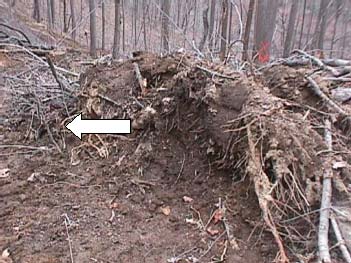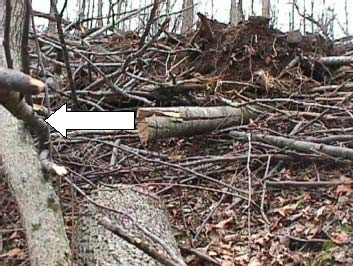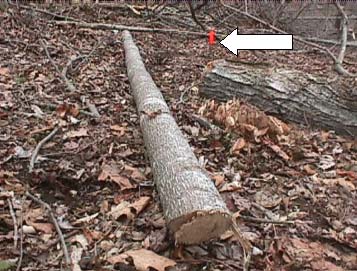West Virginia Dozer Operator Dies After Being Struck-by a Tree which was Pushed Over by the Worker He was Training
Case: 02WV009-01
Release Date: July 24, 2002
SUMMARY
On March 13, 2002, a 34-year-old male heavy equipment operator (victim) died of injuries sustained when he was struck-by a tree which was pushed over on him by the timber cutter he was training to operate his dozer. The victim, who had traded jobs with the worker, was felling trees. He had just felled the last in a series of 7-8 trees and was waiting for the trainee to back down the punch-road in order to hook-up the cable and stabilize the tree from rolling as he removed the last limb. As the dozer approached the dead-end of the punch-road, the winch on the rear of the dozer caught a piece of a tree which was buried in the dirt pile. The movement of the buried tree segment made contact with the root-wad of a standing 73′ foot tall, 5″ diameter poplar. The undetected contact caused the poplar to fall and strike the victim who was waiting approximately 35′ downhill from the dirt pile. Realizing what had happened, the trainee used a CB radio to contact the loader operator who was working at the job’s landing site. The loader operator in turn contacted the owner via a two-way radio. The owner then called 911. After radioing for help, the trainee cut the tree off of the victim and checked for vital signs. Finding none, he assumed he was dead. EMS arrived within 10 minutes. The victim was transported to a medical facility and pronounced dead.
The WV FACE investigator concluded that to reduce the likelihood of similar occurrences, employers should
- ensure that workers are spaced adequately and their duties organized so that their actions will not create a hazard for other workers.
Dozer operators should
- ensure that machines are operated at a distance from other workers so that operation will not create a hazard.
Additionally, timber cutters should
- wait for approaching equipment to be in a position which is at least two tree lengths away from the equipment’s path and final destination.
INTRODUCTION
On March 28, 2002, the WV FACE Program was notified by the West Virginia Division of Forestry (WVDOF) of a heavy equipment work-related fatality which had occurred at a logging site. The WV FACE field investigator contacted the West Virginia Division of Forestry (WVDOF) and discussed the case. The WV FACE field investigator and the WVDOF representative traveled to the site on April 3, 2002 and met with the logging company’s owner to discuss the incident. The owner then accompanied the investigator to the incident site for further investigation. Photographs were also taken at the site. The death certificate and medical examiner’s report were obtained.
The privately-owned 6,000 acre timber stand was being selectively logged for saw timber and pulpwood.
The employer in this incident was a commercial logging company which had been in business for 3 years. At the time of the incident, the workforce totaled 13 including the victim and the owner. The company had a designated safety director (owner) as well as a written safety program. In addition, safety meetings were held monthly.
The company was also a West Virginia Loggers Safety Initiative (WVLSI) participant. WVLSI is a collaborative effort between the West Virginia Workers’ Compensation Division, the West Virginia Forestry Association, the (WVDOF), loggers, and cooperating companies. This initiative is an attempt to establish a comprehensive program that provides immediate Workers’ Compensation rate relief to participating logging companies, while simultaneously addressing the long-term reduction in rates through safety training and performance monitoring. Participating logging companies are also expected to maintain safe work environments for their employees, which includes safe work practices, use of personal protective equipment, ongoing training, and compliance with existing OSHA (Occupational Safety and Health Administration) standards. An ongoing inspection program is an integral part of ensuring that logging companies are maintaining safe work practices.
The victim held Certified Logger status in West Virginia. [Note: The Logging Sediment Control Act of West Virginia (1992) requires that each timbering operation in West Virginia be supervised by a certified logger. To become a certified logger, an individual is required to successfully complete training and pass a test for best management practices (a soil erosion prevention plan) and chain saw safety as well as possess a current first aid card.1]
While the victim’s job at the time of the incident was that of timber cutter, his usual job was dozer operator. He had approximately 13 years of logging experience. He had only been with the company for a little over a year when the incident occurred. At the time of the incident, he was training a timber cutter how to run the dozer. The victim was wearing a hard-hat, hearing protection, face screen, and chaps. He had been felling trees and training the worker approximately 5 hours prior to the incident.
INVESTIGATION
On March 13, 2002, a 34-year-old male heavy equipment operator (victim) died of injuries sustained when he was struck-by a tree which was pushed over on him by the timber cutter he was training to operate his dozer. The victim, who had traded jobs with the worker, was felling trees. He had just felled the last in a series of 7-8 trees and was waiting for the trainee to back down the punch-road in order to hook-up the cable and stabilize the tree from rolling as he removed the last limb. As the dozer approached the dead-end of the punch-road, the winch on the rear of the dozer caught a piece of a tree which was buried in the dirt pile (see Figure 1 ). The movement of the buried tree segment made contact with the root-wad of a standing 73′ foot, 5″ diameter poplar (see Figure 2). The undetected contact caused the poplar to fall and strike the victim who was waiting approximately 35′ downhill from the dirt pile (see Figure 3). Realizing what had happened, the trainee used a CB radio to contact the loader operator who was working at the job’s landing site. The loader operator in turn contacted the owner via a two-way radio. The owner then called 911. After radioing for help, the trainee cut the tree off of the victim and checked for vital signs. Finding none, he assumed he was dead. EMS arrived within 10 minutes. The victim was transported to a medical facility and pronounced dead.
CAUSE OF DEATH
The cause of death listed on the death certificate was cranial cerebral injury.
RECOMMENDATIONS/DISCUSSION
Recommendation #1: Employers should ensure that workers are spaced adequately and their duties organized so that their actions will not create a hazard for other workers.
Discussion: The most noteworthy unsafe condition was the lack of adequate distance between the dozer and the victim. At the time of the incident, the victim was approximately 35 feet directly down hill from the 75 foot tree which the dozer pushed over. Obviously felling a tree when anyone is within the horizontal radius created by the tree’s height when felled is at risk of being struck by the tree. This also stands true for trees being pushed over by equipment whether intentional or not. Therefore establishing and maintaining separation between equipment and workers is crucial. The OSHA Logging Standard CFR 1910.266 (d)(6)(i) requires that employees shall be spaced and the duties of each employee shall be organized so that the actions of one employee will not create a hazard for any other employees.2 One administrative control which employers can use to accomplish this is a logging technique which is known as cold logging. When implementing cold logging techniques, the timber cutters move to the next cutting area before the dozer and/or skidders are brought in. This will ensure safe worker separation even in the event of inadvertent tree felling such as occurred in this incident. Had the employer ensured that the duties of each worker were organized so that the actions of the dozer operator would not create a hazard for the timber cutter this incident would have been avoided.
Recommendation #2: Dozer operators should ensure that machines are operated at a distance from other workers so that operation will not create a hazard.
Discussion: Establishing and maintaining separation between equipment and workers is crucial. Widely accepted tree danger zones range from 2 to 2.5 times the length of the tree being felled or those being pushed over during road construction. Although the puch-road had already been built, the incident was similar to what can occur during road construction when workers are within the danger zone. The OSHA Logging Standard CFR 1910.266 (f)(2)(vii) requires that machines are operated at such a distance from other workers such that operation will not create a hazard for a worker.2 In this incident a less experienced operator was operating a dozer within the danger zone of numerous smaller and therefore less stable trees. Had the operator required the victim to clear the area during his approach, the victim would not have been struck by the tree which was inadvertently pushed over by the dozer.
Recommendation #3: Timber cutters should wait for approaching equipment to be in a position which is at least two tree lengths away from the equipment’s path and final destination.
Discussion: Timber cutters should remain in a heightened state of awareness when equipment approaches their work-zone. Taking the initiative to position themselves out of harms way requires ensuring they are at least two tree lengths away from the equipment’s path and final destination. At the very least, timber cutters should not remain directly down hill of approaching equipment. In this incident, the victim was positioned directly down hill and in line with the approaching dozer. Had the victim been at least two tree lengths away from the dozer’s path or positioned to the side and above the dozer he would not have been struck-by the tree which was inadvertently felled.
REFERENCES:
- West Virginia Logging Sediment Control Act, 1992.
- Office of the Federal Register: Federal Register, Vol. 59, No. 196, 29 CAR 1910.266.
ILLUSTRATIONS

Figure 1. This photo shows the dead end of the punch-road and the dirt pile which contained the buried tree segment. The arrow points to segment.

Figure 2. This photo shows the opposite side of the dirt pile and root wad. The arrow points to the tree which was pushed over on the victim.

Figure 3. This photo shows the segment of tree which hit the victim. The orange flag represents the victim’s position when struck.
FATALITY ASSESSMENT AND CONTROL EVALUATION PROGRAM
The WVU Center for Rural Emergency Medicine, through a contract with the West Virginia Department of Health and Human Resources and Bureau for Public Health, conducts investigations on the causes of work-related fatalities within the state. The goal of this program is to prevent future fatal workplace injuries. West Virginia FACE intends to achieve this goal by identifying and studying the risk factors that contribute to workplace fatalities, by recommending intervention strategies, and by disseminating prevention information to employers, employees, trade associations, unions, equipment manufacturers, students, teachers, and others with an interest in workplace safety.
Please use information listed on the Contact Sheet on the NIOSH FACE website to contact In-house FACE program personnel regarding In-house FACE reports and to gain assistance when State-FACE program personnel cannot be reached.
